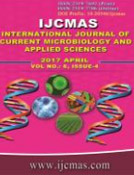


 National Academy of Agricultural Sciences (NAAS)
National Academy of Agricultural Sciences (NAAS)

|
PRINT ISSN : 2319-7692
Online ISSN : 2319-7706 Issues : 12 per year Publisher : Excellent Publishers Email : editorijcmas@gmail.com / submit@ijcmas.com Editor-in-chief: Dr.M.Prakash Index Copernicus ICV 2018: 95.39 NAAS RATING 2020: 5.38 |
A total of 150 dogs brought to Teaching Veterinary Clinical Complex (TCCC), Veterinary College and Research Institute, Namakkal, from September, 2015 to April, 2016 were screened for the haemoparasite, H. canis by blood smear examination and polymerase chain reaction which revealed a positivity of 0.66 and 5.33 per cent, respectively. The PCR was found to have a high sensitivity (100.0%) and specificity (91.27%) when compared with microscopic examination. The target 18S rRNA of H. canis identified was found to possess a 100.0 per cent homology with the H. canis of dogs in Hungary, Italy, Japan, North Africa, Pakistan, Portugal and Thailand. Rhipicephalus sanguineus was the tick vector identified from the positive cases and the males (6.48%), cross breed dogs (10.0%) and the age group of >4 years (9.09%) were found to be highly susceptible.
 |
 |
 |
 |
 |